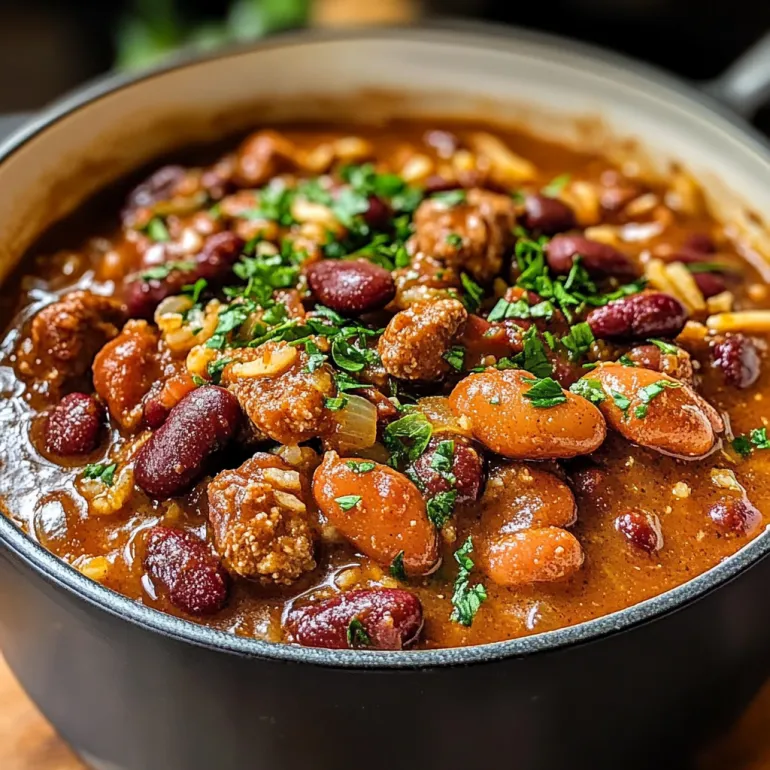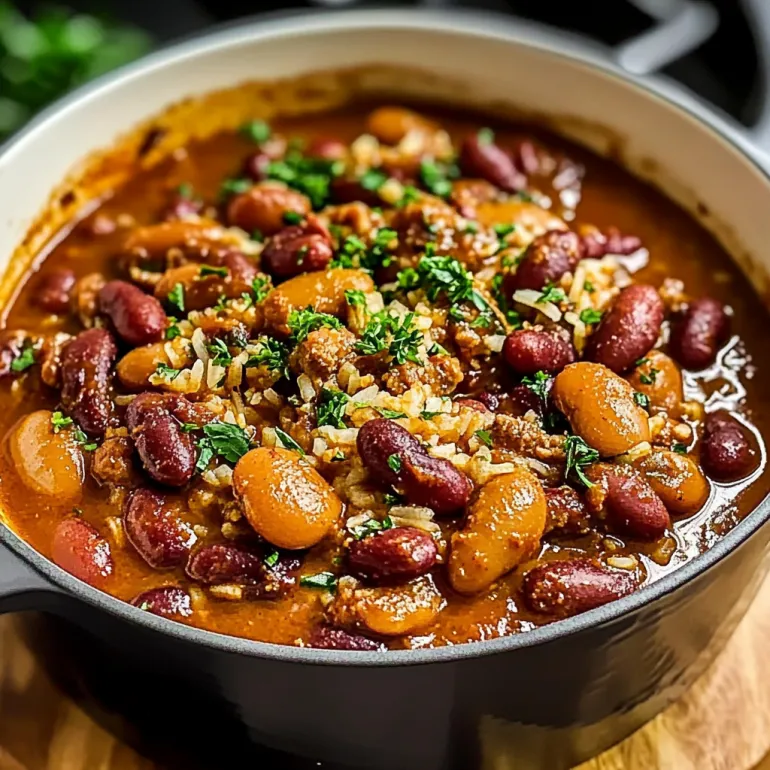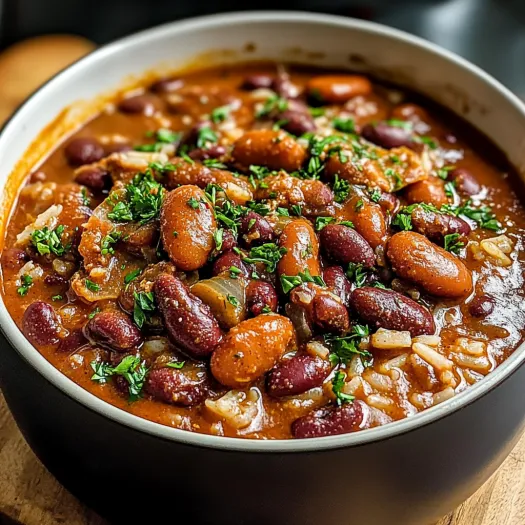 Pin
Pin
This rich and comforting Louisiana Red Beans and Rice has been a cornerstone of Southern comfort food in my kitchen for years. The combination of creamy beans, savory sausage, and aromatic vegetables creates a dish that's both satisfying and deeply flavorful with minimal effort.
I first discovered the magic of red beans and rice while visiting New Orleans during Mardi Gras. The locals taught me that Monday was traditionally "red beans day" because women would put a pot on to simmer while doing laundry. Now it's my go-to weekend project that rewards me with meals all week.
Ingredients
- Dried red kidney beans: Soaked overnight for the perfect texture and flavor. Taking time with dried beans makes all the difference in achieving authentic results.
- Smoked sausage: Preferably andouille for that authentic Louisiana flavor. The smoky richness infuses the entire dish.
- Holy trinity of onion, bell pepper, and celery: Creates the aromatic foundation of Creole cooking. Never skip this crucial flavor base.
- Bay leaves and thyme: Provide the traditional herb profile. These simple herbs contribute subtle complexity.
- White rice: Preferably long grain for serving. The fluffy rice soaks up the flavorful bean liquid beautifully.
Step-by-Step Instructions
- Sauté the Trinity:
- Heat olive oil in a heavy Dutch oven over medium heat until shimmering. Add the onion, bell pepper, and celery, cooking for a full 5 minutes until vegetables soften and onions become translucent. Take your time here as this builds the flavor foundation for the entire dish.
- Brown the Aromatics and Sausage:
- Add minced garlic and sliced sausage to the vegetable mixture. Cook for 3 to 4 minutes, stirring occasionally, until the sausage develops a light brown crust and the garlic becomes fragrant but not burned. This step releases the oils from both ingredients, enhancing the overall flavor profile.
- Simmer to Perfection:
- Add soaked beans, water or broth, bay leaves, thyme, cayenne, salt, and pepper. Bring the mixture to a rolling boil, then immediately reduce to a gentle simmer. Cook uncovered for 2 to 2½ hours, stirring occasionally to prevent sticking. The liquid will slowly reduce, creating a rich sauce while the beans become tender. You'll know they're done when they're soft enough to crush easily against the side of the pot.
- Create the Creamy Texture:
- When beans are tender, use the back of a wooden spoon to mash about a quarter of the beans against the side of the pot. This technique creates the signature creamy texture without needing to add any thickeners. Stir the mashed beans back into the mixture and cook for another 5 minutes to incorporate.
 Pin
Pin
The first time I served this to my Southern grandmother, she gave me her approval with tears in her eyes, saying it tasted just like her mother's recipe. That moment cemented this dish as a family treasure for generations to come. The secret she told me was allowing the beans enough time to release their starch naturally without rushing the process.
Make Ahead and Storage
This dish actually improves with time, making it perfect for meal prep. After cooking, allow the beans to cool completely, then refrigerate in airtight containers for up to 5 days. The flavors will continue to meld and deepen overnight. For longer storage, freeze portions for up to 3 months. Thaw overnight in the refrigerator and reheat gently on the stovetop, adding a splash of water or broth if needed to loosen the mixture.
 Pin
Pin
Historical Background
Red beans and rice dates back to the 18th century in New Orleans where it was influenced by Spanish, Caribbean, and African cooking traditions. The dish became popular during times when meat was scarce as it provided complete protein when combined with rice. The tradition of cooking red beans on Monday came from using the hambone from Sunday dinner and coincided with laundry day when women needed a meal that could simmer unattended while they worked. Today, it remains a cultural touchstone of Louisiana cuisine, served everywhere from home kitchens to fine dining establishments.
Variations and Substitutions
While purists might insist on specific ingredients, don't be afraid to adapt based on what you have available. Canned beans can replace dried beans, reducing cooking time to under an hour—just be sure to drain and rinse them well. Any smoked meat can stand in for andouille, including ham hocks, smoked turkey, or even bacon. Vegetarians can omit meat entirely and use smoked paprika for that characteristic flavor. For a spicier version, add more cayenne pepper or include diced jalapeños with the trinity.
Frequently Asked Questions About the Recipe
- → Can I use canned beans instead of dried?
Yes, canned beans work well for a quicker version. Rinse and drain 3-4 cans of kidney beans and reduce the simmering time to 30-45 minutes. The texture may be slightly different, but the flavor will still be delicious.
- → What can I substitute for andouille sausage?
If andouille isn't available, kielbasa, smoked sausage, or chorizo make good substitutes. For a less spicy option, try smoked ham or turkey sausage. Vegetarians can use plant-based sausage or add extra vegetables and smoky seasonings.
- → How do I get the creamy texture in the beans?
The creaminess comes from mashing some beans against the side of the pot during cooking. Use the back of a spoon to crush about 1/4 of the beans once they're tender, then stir to incorporate the mashed beans into the sauce.
- → What sides pair well with red beans and rice?
Traditional accompaniments include cornbread, collard greens, or a simple side salad. Hot sauce and pickled vegetables also complement the rich flavors. For a complete Louisiana experience, serve with a cold beer or sweet tea.
- → How can I adjust the spice level?
Control the heat by adjusting the cayenne pepper amount. For milder flavor, omit it entirely or use just a pinch. For more spice, increase to 1 teaspoon or add hot sauce during cooking. Serving hot sauce on the side lets everyone customize their own bowl.
- → Can I make this dish in advance?
Absolutely! Like many bean dishes, the flavors actually improve after a day in the refrigerator. Make it up to 3 days ahead and reheat gently on the stovetop. You may need to add a splash of water or broth when reheating.
